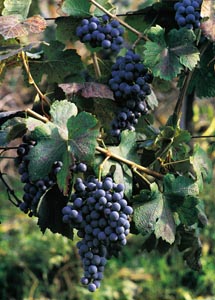- Glass Making in Roman Times
- Roman Wine: A Window on an Ancient Economy
- Roman Wine: Windows on a Lifestyle
- Fine Glassware in the Roman World
- Reuse of Images in the Art of Rogier van der Weyden
Chemistries of Flavor

A fine harvest of black grapes
A grape is about 15% solids (as skin, stem, and seeds) and about 85% pulp and juice that we call the must. Most of the must is water: its sugar content, as a mix of glucose and fructose, ranges between 18% and 25% by weight. Grapes used for table wines contain glucose and fructose in roughly equal amounts; those used for dessert wines have rather more fructose.
Acids make up about 0.3% to 1.5% of a grape's weight. The main acids are tartaric and malic, but there are small amounts of other ones as well (citric and oxalic, among them) each of which influence the micro-chemistry of winemaking to some degree. Meanwhile, various amino acids, vitamins, and minerals provide nutrients to the fermenting yeasts and so also effect wine's aroma. Tannins in a grape's skin contribute the astringency that characterizes red wines, which are fermented from a mash of the entire grape; and a handful of pigments (anthocyanins) give wine its color.
